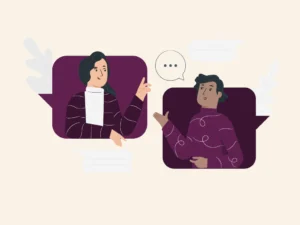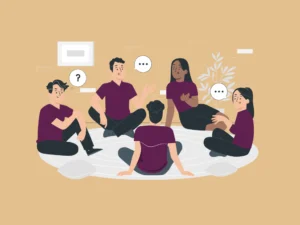The rise of telehealth has reshaped how clinicians build and sustain the therapeutic alliance in virtual settings, a core element of effective treatment. As virtual care continues to expand, many practitioners are learning how to create meaningful client connections through video-based platforms. While this approach offers greater flexibility and accessibility, it also brings important questions to the surface. Can trust, empathy, and rapport develop as strongly through a screen? This guide explores the evolving nature of the therapeutic alliance in virtual settings and offers practical insights for therapists working in this growing area of care.
Therapeutic Alliance in Teletherapy
The therapeutic alliance—the collaborative and affective bond between therapist and client—has long been considered a key predictor of positive treatment outcomes. While much is known about this relationship in face-to-face therapy, its role in teletherapy is still being studied. In this new context, a critical question arises: Can the therapeutic alliance maintain its impact through a screen?
A recent study that pulled together data from dozens of smaller studies found that the bond between therapist and client still matters in teletherapy. The connection might not be quite as strong as in face-to-face sessions, but it does have a real impact on how well people do in treatment. Interestingly, this connection seemed even more important when it was measured later in the therapy process and when clients themselves rated how things were going. So while building a strong relationship online might work a bit differently, it’s still an important piece of the puzzle.
Consider the case of Maria, who struggled with social anxiety. Meeting her therapist online initially allowed her not to face the anxiety-provoking aspects of an office and sitting in a waiting room. Over time, this comfort enabled a deeper therapeutic connection than might have otherwise been impossible during the early stages of treatment.
However, the alliance in teletherapy requires intentional cultivation. Without the shared physical environment, therapists must adapt their approaches to create psychological presence and connection through the screen.
How Videoconferencing Impacts the Therapeutic Relationship
Videoconferencing introduces distinct dynamics that reshape the therapeutic encounter. The frame becomes literal—bound by screen dimensions and camera angles. This framing limits what therapists can observe about client body language and surroundings while simultaneously inviting glimpses into private spaces that wouldn’t be visible during office visits.
Technical difficulties create ruptures in the therapeutic flow. Lagging connections, frozen screens, or audio issues can interrupt important moments and require additional repair work in the relationship.
Eye contact functions differently online. The inability to make true eye contact (looking at the camera versus looking at the client’s image) subtly alters the experience of connection for both parties.
Self-view creates self-consciousness. Both therapist and client can observe themselves during sessions, potentially increasing self-monitoring and performance anxiety.
Distractions multiply in home environments. Notifications, household members, pets, and the temptation to multitask can pull attention away from the therapeutic exchange.
A therapist described noticing how his own attention drifted more easily during video sessions. “In the office, the environment is controlled and dedicated to therapy. Online, I found myself needing to develop new mental disciplines to stay fully present with clients.”
Despite these challenges, videoconferencing also opens new possibilities. Therapists can observe clients in their natural environments, gaining insights into their actual living situations. Also, the technology allows for screen-sharing and other collaborative work on therapeutic materials that might not be possible in traditional settings.
Factors That Influence Alliance in Online Therapy
Several key factors shape how successfully therapeutic alliances develop in virtual spaces. Technical competence and comfort of both therapist and client might significantly impact the alliance as well. Practitioners who look flustered by technology may appear lacking in confidence or competence to clients.
Environmental factors, including privacy, lighting, sound quality, and seating arrangements, create the foundation for therapeutic engagement. Some clients join from cars, shared spaces, or while walking and may struggle to engage deeply with therapeutic content.
Client characteristics and preferences play important roles. Some client populations adapt rapidly to telehealth (often younger clients or those with mobility limitations), while others find the medium alienating or difficult to navigate.
Pre-existing relationship quality influences transition success. Established therapeutic relationships generally transfer more smoothly to online formats than newly formed ones.
Therapeutic approach compatibility varies across modalities. While many therapeutic approaches translate effectively to video, those emphasizing physical presence or environmental manipulation (like some trauma approaches) may require creative adaptation.
Flexibility proves essential. Those who rigidly attempt to replicate in-person protocols without adaptation may experience greater alliance difficulties than those who thoughtfully reimagine their practice for the virtual environment.
Therapist Behaviors That Strengthen Alliance Online
Therapists can actively cultivate stronger alliances through specific behaviors adapted for videoconferencing. Enhanced verbal presence compensates for reduced nonverbal communication. Successful teletherapies often employ more frequent verbal acknowledgments, process comments, and direct questions about the client’s emotional experience.
Deliberate nonverbal communication becomes crucial. Increased facial expressiveness, visible nodding, and hand gestures help convey attentiveness and empathy through the screen.
Technical preparation prevents disruptions. Taking time before sessions to check equipment, close unnecessary programs, and ensure good lighting and sound quality demonstrates respect for the therapeutic hour and client experience.
The experience becomes more normalized when the medium is brought up explicitly. Instead of letting technology remain an unresolved barrier, it can be incorporated into the therapeutic relationship by starting discussions about how videoconferencing feels different, admitting technical difficulties, and asking for feedback on the virtual format.
Consistent framing and environment provide continuity. Therapists who maintain a professional background, consistent positioning, and similar appearance across sessions create a sense of reliability that supports alliance development.
A psychologist specializing in trauma treatment describes establishing a pre-session ritual with her online clients: They take two minutes at the beginning of each session to settle into their spaces, adjust posture, and take a few mindful breaths together. This creates a transition that helps establish a good therapeutic setting.
Client Perceptions and Experiences in Videoconferencing Therapy
Understanding how clients experience videoconferencing therapy provides valuable insights for strengthening alliance.
Many clients may initially feel uncertain about therapeutic boundaries in virtual settings. The blend of professional interaction within personal space might create confusion about session formality and expectations.
Telehealth clients highlight both convenience benefits and connection challenges. While it eliminates travel time and increases scheduling flexibility, some may miss the ritual aspect of physically traveling to therapy and having a dedicated space separate from daily life.
Client feedback indicates the importance of session preparation guidance. Therapists who provide clear recommendations about creating suitable environments for virtual sessions (privacy, reduced distractions, comfortable seating) help them maximize therapeutic benefit.
Successful adaptation often involves acknowledging the differences rather than pretending videoconferencing is identical to in-person therapy. Clients appreciate therapists who demonstrate understanding of the unique challenges while conveying confidence in the effectiveness of virtual treatment.
Tools and Strategies to Improve Online Therapeutic Alliance
Practical approaches can enhance connection and effectiveness in videoconferencing therapy.
Expanded intake procedures that address technological considerations help establish clear expectations. Smart intake processes include discussions about backup plans for technical failures, privacy arrangements, and orientation to the videoconferencing platform.
Shared digital workspaces facilitate collaborative therapeutic work. Tools like shared whiteboards, document editors, or therapy-specific platforms allow for interactive exercises that engage clients actively in the therapeutic process.
Modified clinical techniques address the constraints of video sessions. For example, therapists might replace full-body progressive muscle relaxation with abbreviated versions more suitable for on-camera work, or adapt exposure hierarchies to account for the online environment.
The use of chat features adds dimension to communication. The selective use of text chat for resource sharing, important points, or exercises provides another channel for connection when appropriate.
A cognitive-behavioral therapist described adapting thought records for online use: “We created a digital template that we could both see and edit in real-time. This interactive approach actually increased client engagement compared to the traditional paper method used in my office.”
Research Findings and Evidence-Based Insights
Comparable Alliance Strength to In-Person Therapy
Recent research reveals encouraging news for virtual therapy. A comprehensive analysis comparing videoconferencing therapy to traditional in-person sessions found no meaningful differences in how strong the therapeutic relationship became. Both patients and therapists rated their connections similarly, whether they met face-to-face or through screens. This finding suggests that the fundamental human bond central to healing can develop just as effectively in virtual spaces.
Small but Meaningful Impact on Treatment Outcomes
The quality of the therapeutic relationship in online therapy does make a difference in how well treatment works. Studies show that stronger alliances lead to better outcomes, though the effect tends to be modest. The connection becomes more important as therapy progresses, and patients often notice the benefits more clearly than outside observers might measure them.
Client Perceptions Often Exceed Therapist Expectations
An interesting pattern emerges when comparing how clients and therapists view their online relationships. Clients frequently rate their therapeutic connections more positively than their therapists do in virtual settings. This gap suggests that therapists might underestimate the strength of bonds they’re building through screens, while clients feel genuinely connected and supported.
Therapist Confidence Grows with Experience
Many therapists initially feel uncertain about developing strong relationships through video calls compared to meeting in person. However, this hesitation typically fades as therapists gain more experience with virtual sessions. Those who have conducted more online therapy report feeling significantly more confident in their ability to connect with clients and build meaningful therapeutic relationships.
Digital Fluency as Professional Competency
The therapy field increasingly recognizes that understanding online culture has become essential for effective treatment. Therapists who develop comfort with digital communication and appreciate how clients navigate their online lives often see improved treatment results. This “digital fluency” or “onlineness” helps bridge generational and cultural gaps that might otherwise interfere with the therapeutic process.
Special Considerations
Certain clinical situations present unique challenges and opportunities for therapeutic alliance in videoconferencing.
Crisis management requires additional planning. Therapists must establish clear protocols for addressing emergent suicidality, self-harm, or situational crises when physically distant from clients.
Confidentiality concerns shift in home environments. The presence of family members, roommates, or others nearby introduces privacy challenges that may affect client disclosure and alliance development.
Boundary management becomes more complex. The blending of therapeutic space with living space can blur professional boundaries, requiring thoughtful navigation.
Screen fatigue impacts therapeutic work. Both therapists and clients may experience increased cognitive load and attention fatigue during video interactions, affecting engagement quality.
Documentation and record-keeping adapt to the medium. Therapists must consider how to document observations and interventions when visual data may be limited by the camera frame and technical quality.
Working with children or trauma survivors
Specific populations require tailored approaches to alliance-building in videoconferencing therapy.
Children present developmental considerations that shape online engagement. Shorter attention spans, greater physical activity, and different technological comfort levels necessitate adapted techniques. Successful child therapists often incorporate more movement, visual aids, and interactive activities to maintain connection.
Case example: A play therapist incorporated “virtual play” by sending identical small toy sets to herself and a young client, allowing parallel play experiences despite physical separation. This shared activity provided a foundation for therapeutic interaction that bridged the digital divide.
Trauma treatment involves unique challenges online. The physical distance can both help and hinder trauma work—some clients feel safer discussing traumatic material from their own environments, while others struggle with the lack of physically present support during emotional processing.
Grounding techniques require adaptation for virtual delivery. Therapists working with trauma survivors have developed modified approaches to maintaining present-moment awareness through screens, often emphasizing sensory experiences available in the client’s environment.
Parent involvement shifts in teletherapy with children. Parents may become more active participants in the therapeutic process when therapy happens from home, creating both opportunities for family engagement and potential confidentiality challenges.
A trauma specialist reported developing a “virtual safe place” protocol: “We collaborate to identify a specific location in the client’s home where therapy will consistently occur, then work together to make that space feel safe. For some clients, this actually facilitates trauma processing because the therapeutic space becomes integrated with their daily environment.”
Cultural and accessibility barriers
Videoconferencing both addresses and creates barriers to therapeutic alliance across different populations. Cultural differences in communication styles may be amplified or muted online. Non-verbal communication patterns and expectations around directness vary across cultures, sometimes creating misalignment that’s harder to detect and address through screens.
Language barriers become more challenging without full access to body language and environmental cues that often supplement verbal communication in cross-language therapeutic work.
Digital divide issues affect access and experience quality. Socioeconomic factors influencing technology access, internet reliability, and private space availability create disparities in who can successfully engage in videoconferencing therapy.
Accessibility for disabled clients varies by disability type. While telehealth removes transportation and physical access barriers for many, it creates new challenges for clients with visual impairments, hearing limitations, or cognitive processing differences.
Some Final Thoughts
The shift to videoconferencing therapy has changed how therapists and clients connect, but it hasn’t weakened the therapeutic relationship. Strong alliances can develop just as effectively through screens as they do in person, though this requires intentional adaptation.
What’s encouraging is that clients often feel more connected than their therapists expect. Therapists may underestimate their ability to build meaningful relationships through technology. As therapists gain experience with online sessions, their confidence grows and relationships strengthen.
The future will likely blend virtual and in-person approaches, making digital skills essential for therapists. Success comes from adapting techniques thoughtfully rather than trying to replicate office visits exactly. The screen changes how therapists connect with clients, but it doesn’t change why that connection matters for healing.
References
Aafjes-van Doorn, K., Spina, D. S., Horne, S. J., & Békés, V. (2024). The association between quality of therapeutic alliance and treatment outcomes in teletherapy: A systematic review and meta-analysis. Clinical Psychology Review, 110, 102430. https://doi.org/10.1016/j.cpr.2024.102430
Gajarawala, S. N., & Pelkowski, J. N. (2021). Telehealth Benefits and Barriers. The journal for nurse practitioners : JNP, 17(2), 218–221. https://doi.org/10.1016/j.nurpra.2020.09.013
Hobart, P. J. (2022, June 9). Therapists should build a new cultural competence: “Onlineness”. WIRED. https://www.wired.com/story/therapy-mental-health-extremely-online
Sucala, M., Schnur, J. B., Brackman, E. H., Constantino, M. J., & Montgomery, G. H. (2013). Clinicians’ attitudes toward therapeutic alliance in E-therapy. The Journal of general psychology, 140(4), 282–293. https://doi.org/10.1080/00221309.2013.830590
Seuling, P. D., Fendel, J. C., Spille, L., Göritz, A. S., & Schmidt, S. (2024). Therapeutic alliance in videoconferencing psychotherapy compared to psychotherapy in person: A systematic review and meta-analysis. Journal of telemedicine and telecare, 30(10), 1521–1531. https://doi.org/10.1177/1357633X231161774
Why other mental health professionals love Mentalyc

“It keeps me on a level of assessment about the relationship that has a little bit more objectivity … helps keep me grounded.”

“Reading transcripts helps me tighten up and come across more the way I want to present myself to clients … it’s helped me improve and keep getting better.”
Licensed Marriage and Family Therapist

“Using Alliance Genie has really improved my notes … It tells me what I’m doing and gives me an approach of what’s next.”

“It’s really giving me some good confidence … and areas of improvement to see nuances I didn’t see before.”







